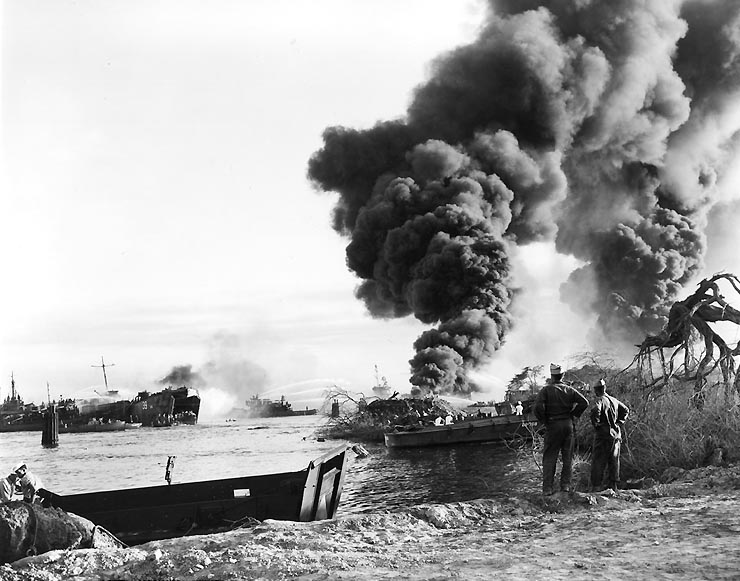
Zo679. Smoke rises from the wreck of USS LST-480, at right, as tugs and other craft try to put out her fires. At left is USS LST-39, also burning, with men on her bow ramp, probably removing cargo, and other vessels alongside and nearby. Photograph is dated 22 May 1944, the day after the explosion. Image, curtesy of Wikipedia.
————————————————-
This is a Pearl Harbor Story, I often heard about, when I was stationed here but only now, did I dig into this WWII tragic story that caused many, many casualties.
All the pictures and texts came from these two internet sources, first, this Wikipedia page or click here:
https://en.wikipedia.org/wiki/West_Loch_disaster
And from Ned Forney’s Facebook page, Writer, Saluting America’s Veterans, click here:
The West Loch Disaster was a maritime accident during World War II at Pearl Harbor U.S. Naval Base in Hawaii. The incident, which occurred just after 3:00 p.m. on Sunday, May 21, 1944, began following an explosion in a staging area for Landing Ships, Tank (LSTs) and other amphibious assault ships in West Loch. A fire quickly spread among the ships being prepared for Operation Forager, the invasion of the Japanese-held Mariana Islands. Over the next 24 hours, six LSTs sank, 163 naval personnel died, and 396 were injured. Text, curtesy of Wikipedia,
——————————————-

Zo680. Boatswain’s Mate Second Class and Navy Deep Sea Diver Owen Francis Patrick Hammerberg, United States Navy. Image and the text below are curtesy of Ned Forney’s Facebook page, Writer and Saluting America’s Veterans
He sacrificed his life for his buddies . . .
Born on May 31, 1920, in Daggett, Michigan, Owen Francis Patrick Hammerberg quit high school, left home to work on a ranch, and in July of 1941, hoping for a life of adventure and travel, enlisted in the Navy.
Less than five months later, the Japanese attacked Pearl Harbor.
With America now at war, Hammerberg served aboard the battleship USS Idaho (BB-42) and mine sweeper USS Advent (AM-83). He went on to graduate from Deep Sea Diving school and then reported to Pacific Fleet Salvage Force in Pearl Harbor.
On February 17, 1945, Petty Officer 2nd Class Hammerberg volunteered to rescue two divers trapped in 40 feet of dark, mud-filled water laced with “jagged pieces of steel.”
The men had become entangled in the wreckage of an LST, or Landing Ship Tank (a flat-bottomed, nearly 400-foot-long amphibious vessel designed to carry tanks, troops, and equipment onto invasion beaches), in Pearl Harbor’s West Loch and were desperately hoping to be rescued.
Over the next 18 hours, Boatswain’s Mate Hammerberg repeatedly risked his life to navigate through pitch-black water, entangled hoses, and oozing mud to reach his buddies.
After rescuing the first diver, Hammerberg was making his way to the second man when a cave-in occurred. With a massive steel plate and thick mud showering down on him, the seemingly fearless diver used his body to shield his fellow American.
By “placing the full brunt of the terrific pressure on himself,” Hammerberg saved the life of the salvage diver, who then broke free of the wreckage and escaped to the surface.
Hammerberg, however, wasn’t as lucky. After struggling for hours to stay alive, the injured diver lost consciousness. For his buddies on the surface, who had been talking with him via an underwater phone line, the silence was deafening. The 24-year-old’s body was recovered two days later.
For sacrificing his life to save his fellow divers, Boatswain’s Mate Hammerberg was posthumously awarded the Medal of Honor, becoming the only US Navy diver in WWII to receive America’s highest award for valor.
Postscript:
In a letter to Hammerberg’s parents, US Navy Commander Henry Foss described the final moments of the fallen sailor’s life: “Close friends of your son stood by his telephone giving him such comfort and encouragement as was possible under the circumstances.”
———————————————

Zo681. Owen Hammerberg’s final resting place at Holy Sepulchre Cemetery, Southfield, Michigan. (PC: findagrave). Image and the text are curtesy of Ned Forney’s Facebook page, Writer and Saluting America’s Veterans

Zo682. USS Hammerberg (DE-1015) underway in 1957. (PC: US Navy), USS Hammerberg (DE-1015), 1955-1974, was named in honor of BM2 Owen F.P. Hammerberg. Image and the text are curtesy of Ned Forney’s Facebook page, Writer and Saluting America’s Veterans

Zo683. Pearl Harbor naval base. The West Loch is the arm of Pearl Harbor on the left side of the image. Image, curtesy of Wikipedia.

Zo684. The rusting remains of LST-480 at 21°21′26.04″N 157°59′50.05″W. When I was an instructor in the Pearl Harbor Diving School 1973-75, we had our diving students do their long swims here and nearby we did our salvage training. Image, curtesy of Wikipedia.

Zo685. A US Navy salvage diver at Pearl Harbor. (PC: San Diego Tribune). Image and the text are curtesy of Ned Forney’s Facebook page, Writer and Saluting America’s Veterans

Zo686. USS LST-480 afire again on 23 May 1944. The sunken remains of USS LST-353 are off her starboard bow. The beached and burned out hulk of LST-39 is in the left distance. Note the amphibious tractors (LVTs) parked in the left foreground. Image, curtesy of Wikipedia.

Zo687. The burned hulk of LST-39 on 21 May 1944. Image, curtesy of Wikipedia.

Zo488. LST-480 on 22 May 1944.
Overhead view of the burning hulk of USS LST-480 in the West Loch at Pearl Harbor, 22 May 1944. The yard craft with her bow on the stern of LST-480 appears to be a self-propeller covered lighter.
Unknown author – Photo from the Army Signal Corps Collection in the US National Archives. Photo # SC 276944. Image, curtesy of Wikipedia.
Note from Karl: In 1963, I proudly became a Boatswain’s Mate Second Class and Navy Deep Sea Diver.